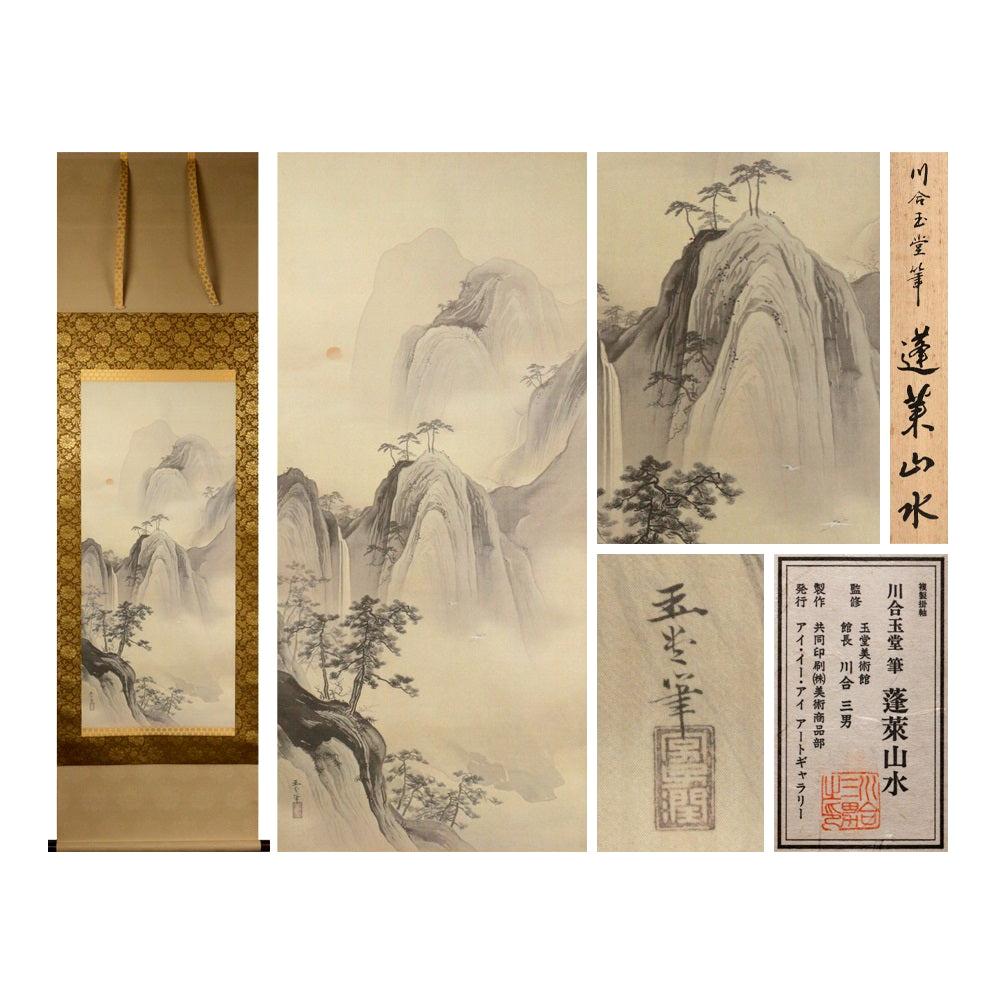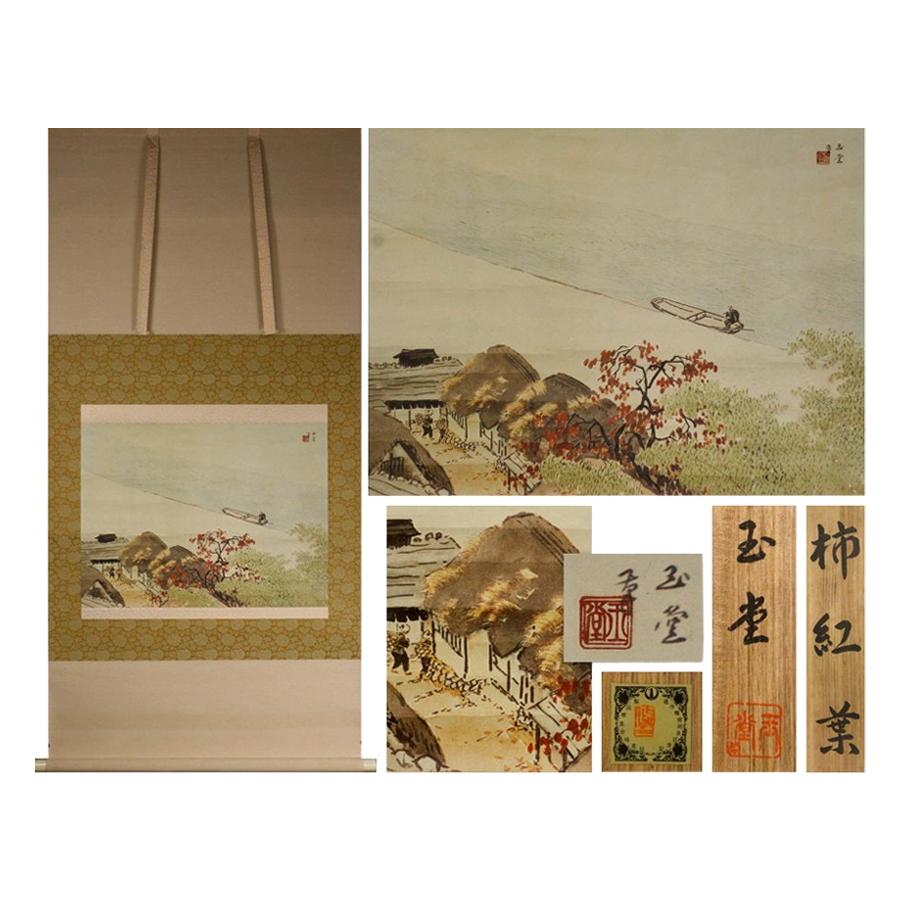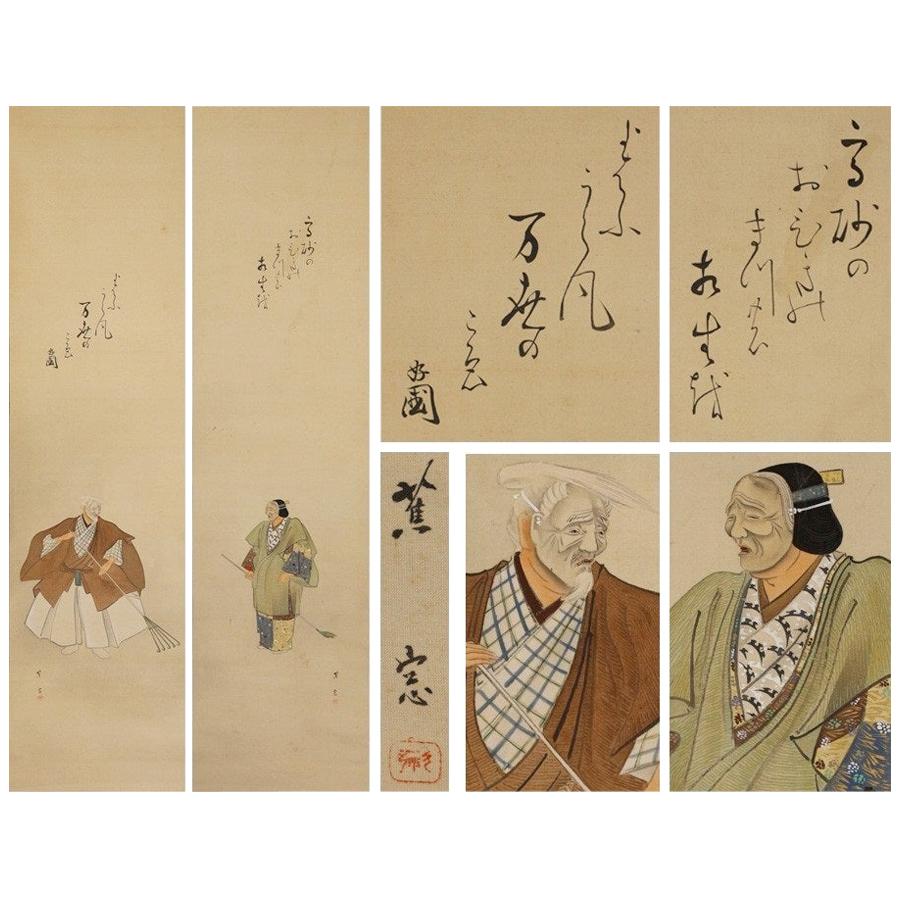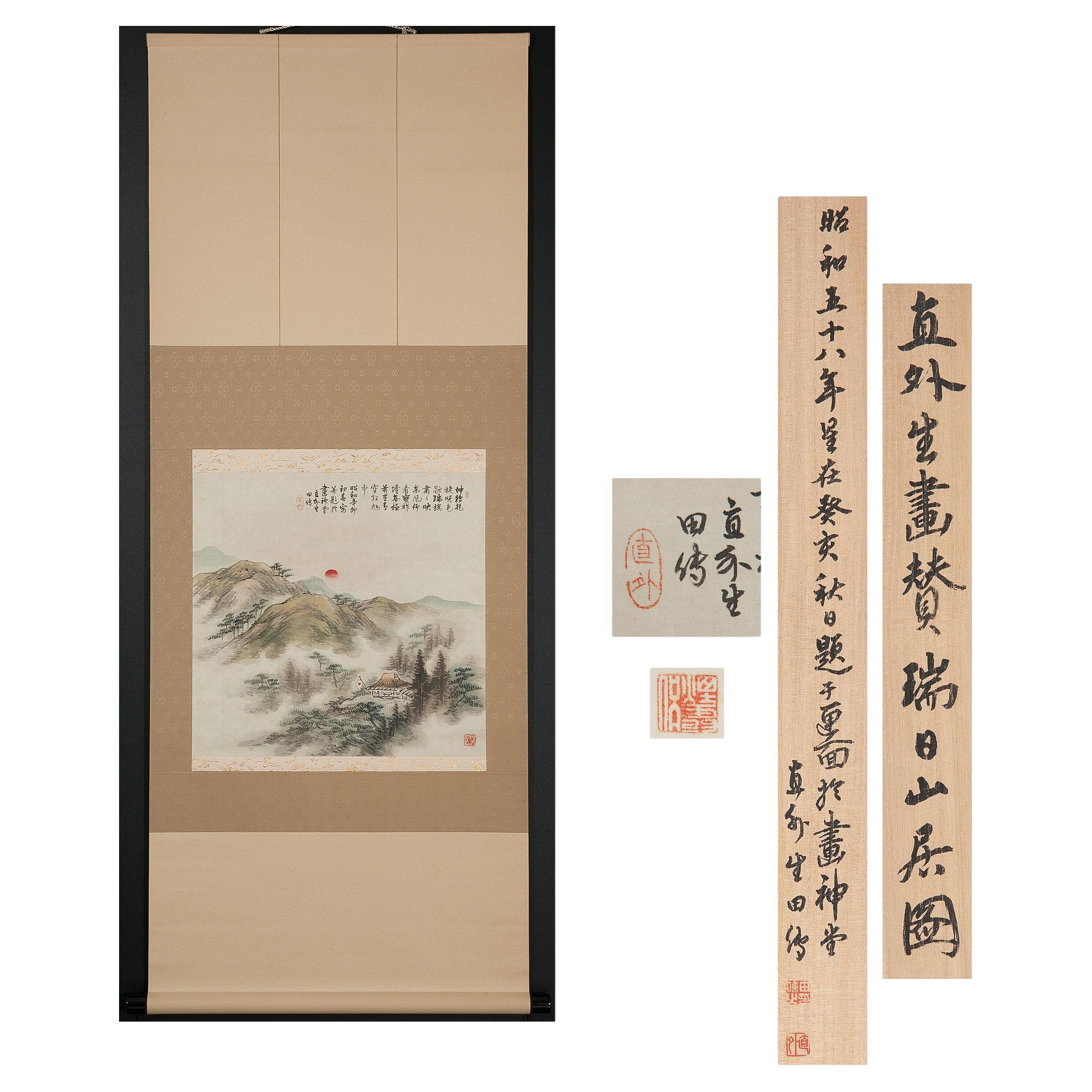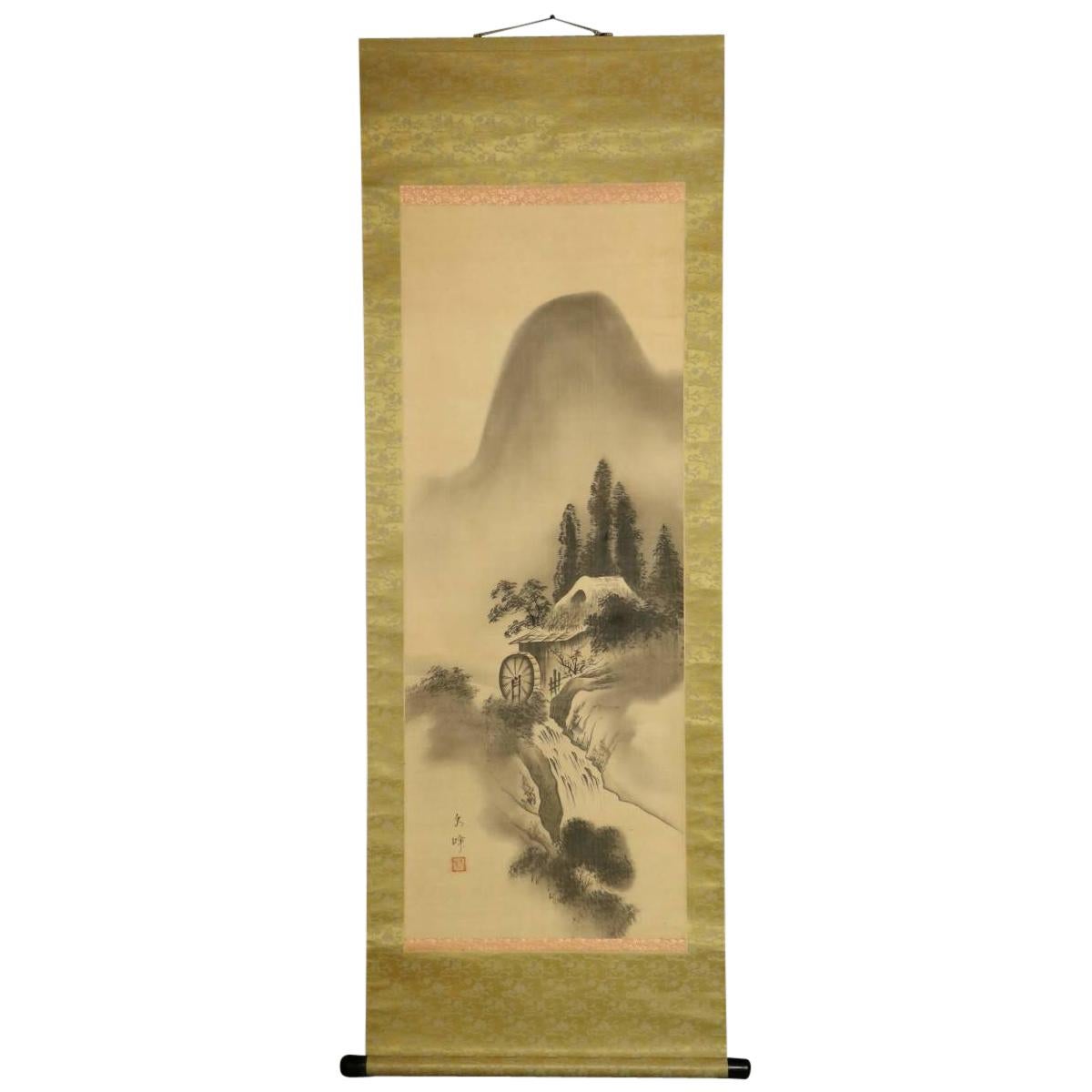Items Similar to Kawai Gyokudō Nihonga Scene Early 20th Century Scroll Painting Japan Artist
Want more images or videos?
Request additional images or videos from the seller
1 of 7
Kawai Gyokudō Nihonga Scene Early 20th Century Scroll Painting Japan Artist
About the Item
It is a high-quality craft of the work drawn by Kawai Gyokudo as you can see.
It creates a texture that makes you feel a refreshing breeze, and it is
a tasty work that is carefully drawn even to lush bushes and trees.
(A guidebook (bookmark) is also included.)
"Kawaai Gyokudo"
[1873-1957] Japanese painter. Born in Aichi.
His real name is Hosaburo. Another issue, Ikuan.
At the beginning, he studied under the Shijo school and then Masakuni Hashimoto to study the Kano school, and established
his own style as a moderate landscape painting full of poetry.
Received the Order of Culture. Work "Ayaame" etc.
¦ Paper books and crafts.
¦ The condition is
beautiful.
¦ Axial dimension/approx. 128.0 cm x 62.0 cm.
¦ Paper size/approx. 40.5 cm x 51.0 cm.
¦ Incorporation/There are inscriptions/incorporations as you see.
¦ Box/Box.
awai Gyokudo (?? ??, November 24, 1873 – June 30, 1957) was the pseudonym of a Japanese painter in the nihonga school, active from Meiji through Showa period Japan. His real name was Kawai Yoshisaburo.
Contents
Biography
Gyokudo was born in what is now Ichinomiya city, Aichi Prefecture, as the eldest son of a paper, ink and brush merchant. He went to Kyoto in 1887 to study under Kono Bairei of the Maruyama-Shijo school of painting. In 1896, he moved to Tokyo and he became the student of Hashimoto Gaho, of the Kano school. He also studied Western-style painting and developed a highly personal style, especially in the field of landscape painting.
Gyokudo is noted for his polychrome and occasionally monochrome works depicting the mountains and rivers of Japan in the four seasons, with humans and animals shown as part of the natural landscape. Among his representative works are Futsuka zuki (“The New Moon”), Yuku haru (“The Departing Spring”), Mine-no-yu (“Evening at the Mountain Top”), and Bosetsu (“Snow in the Evening”).
In 1898, Gyokudo joined with Okakura Tenshin and Yokoyama Taikan to found the Nihon Bijutsuin (Japan Fine Art Academy). In 1907, Gyokudo was selected as a judge for the first annual Bunten Exhibition. He became a teacher at the Tokyo Bijutsu Gakko (the forerunner of the Tokyo National University of Fine Arts and Music) in 1919.
In 1940, he was awarded the Order of Culture by the Japanese government.
Most of his works are preserved and displayed at the Gyokudo Art Museum, in Ome, Tokyo.
- Dimensions:Height: 50.4 in (128 cm)Width: 24.41 in (62 cm)Depth: 0.04 in (1 mm)
- Style:Taisho (Of the Period)
- Materials and Techniques:
- Place of Origin:
- Period:
- Date of Manufacture:19th-20th Century
- Condition:Wear consistent with age and use. ■ The condition is beautiful. ■ Axial dimension/approx. 128.0 cm x 62.0 cm. ■ Paper size/approx. 40.5 cm x 51.0 cm. ■ Incorporation/There are inscriptions/incorporations as you see. ■ Box/Box.
- Seller Location:Amsterdam, NL
- Reference Number:
About the Seller
5.0
Gold Seller
These expertly vetted sellers are highly rated and consistently exceed customer expectations.
Established in 2015
1stDibs seller since 2019
158 sales on 1stDibs
Typical response time: 11 hours
- ShippingRetrieving quote...Ships From: Amsterdam, Netherlands
- Return PolicyA return for this item may be initiated within 14 days of delivery.
More From This SellerView All
- Artists Kawai Gyokudō Showa Period Scroll Japan 20c Artist NihongaLocated in Amsterdam, Noord HollandKawai Gyokudo (?? ??, November 24, 1873-June 30, 1957) was the pseudonym of a Japanese painter in the Nihongo school, active from Meiji through Showa period Japan. His real name was Kawai Yoshisaburo. Contents Biography Gyokudo was born in what is now Ichinomiya city, Aichi Prefecture, as the eldest son of a paper, ink and brush merchant. He went to Kyoto in 1887 to study under Kono Bairei of the Maruyama-Shijo school of painting. In 1896, he moved to Tokyo and he became the student of Hashimoto Gaho, of the Kano school. He also studied Western-style painting and developed a highly personal style, especially in the field of landscape painting. Gyokudo is noted for his polychrome and occasionally monochrome works depicting the mountains and rivers of Japan in the four seasons, with humans and animals shown as part of the natural landscape. Among his representative works are Futsuka zuki (“The New Moon”), Yuku haru (“The Departing Spring”), Mine-no-yu (“Evening at the Mountain Top”), and Bosetsu (“Snow in the Evening”). In 1898, Gyokudo joined with Okakura Tenshin and Yokoyama Taikan...Category
20th Century Japanese Taisho Paintings and Screens
MaterialsSilk
- Artists Kawai Gyokudō Showa Period Scroll Japan 20c Artist NihongaLocated in Amsterdam, Noord HollandKawai Gyokudo (?? ??, November 24, 1873-June 30, 1957) was the pseudonym of a Japanese painter in the Nihongo school, active from Meiji through Showa period Japan. His real name was Kawai Yoshisaburo. Contents Biography Gyokudo was born in what is now Ichinomiya city, Aichi Prefecture, as the eldest son of a paper, ink and brush merchant. He went to Kyoto in 1887 to study under Kono Bairei of the Maruyama-Shijo school of painting. In 1896, he moved to Tokyo and he became the student of Hashimoto Gaho, of the Kano school. He also studied Western-style painting and developed a highly personal style, especially in the field of landscape painting. Gyokudo is noted for his polychrome and occasionally monochrome works depicting the mountains and rivers of Japan in the four seasons, with humans and animals shown as part of the natural landscape. Among his representative works are Futsuka zuki (“The New Moon”), Yuku haru (“The Departing Spring”), Mine-no-yu (“Evening at the Mountain Top”), and Bosetsu (“Snow in the Evening”). In 1898, Gyokudo joined with Okakura Tenshin and Yokoyama Taikan...Category
20th Century Japanese Taisho Paintings and Screens
MaterialsSilk
- Actors in Dance / Theatre Scene 20th Century Scroll Painting Japan ArtistLocated in Amsterdam, Noord HollandIt is a work of 2 scrolls figure in a Theatre/Dance Noh style. it is a very tasty work combined with the hymns spelled at the top. ¦ Silk books and handwriting. ¦ State There ...Category
Early 20th Century Japanese Taisho Paintings and Screens
MaterialsSilk
- Lovely Scroll Painting Japan, 20th Century 'Showa' Artist Landscape SceneLocated in Amsterdam, Noord HollandLovely painting! Overall perfect: Size scroll, vertical 138.3 cm horizontal 54 cm picture, vertical 40.3 cm horizontal 42 cm Condition: Overall perfect: Size scroll, vertica...Category
20th Century Japanese Meiji Paintings and Screens
MaterialsBronze
- Artists Suiho Yano Showa Period Scroll Japan 20c Artist NihongaLocated in Amsterdam, Noord HollandAs you can see, it is a work of "Basho / Sparrow" drawn by Midori Yano. Under Basho, this work skillfully depicts the appearance of sparrows forming a flock and singing food. «Su...Category
20th Century Japanese Taisho Paintings and Screens
MaterialsSilk
- Lovely Nihonga Scene Meiji/Taisho Period Scroll Japan Artist PaintingLocated in Amsterdam, Noord HollandLovely Nihonga scene Meiji/Taisho period scroll Japan artist painting. Painting size: (Width x height) mm 525 x 1499.Category
Antique 19th Century Japanese Meiji Paintings and Screens
MaterialsSilk
You May Also Like
- Early 20th Century Japanese Framed Painting, White Peacocks on Silk and GoldLocated in Kyoto, JPKasahara Seiken White peacocks, circa 1916 Framed painting. Ink, color and gofun on silk. A Taisho period Japanese nihonga painting depicting a pair of white peacocks re...Category
Early 20th Century Japanese Taisho Paintings and Screens
MaterialsGold Leaf
- Japanese Screen, Early 20th Century Wagtail & Chrysanthemum by Ishizaki KoyoLocated in Kyoto, JPIshizaki Koyo (1884-1947) Wagtail & Chrysanthemum Early 20th century Folding screen in two-panels. Ink, pigments and gofun on gold leaf. Sign: Koyo Seal: Koyo This ...Category
Early 20th Century Japanese Taisho Paintings and Screens
MaterialsGold Leaf
- Vintage Japanese Two-Panel Screen, Taisho Period, Early 20th CenturyLocated in Prahran, VictoriaJapanese two-panel screen, study of an Okinawan mother and child, Taisho period early 20th century, dating from the 1920's. Signed by Matsumura Baiso, (1884-1935). Baiso was a studen...Category
Early 20th Century Japanese Taisho Paintings and Screens
- Album of Japanese Shunga 28 Paintings Early 20th CenturyLocated in Norton, MAAlbum of erotic paintings. Japan. Early 20th century. Shunga with 28 paintings, real hand-painted. Ink and colors on silk. Brocade mounts. 9.25 x 7in. Image sizes from (4" ~ 4.5") W ...Category
Early 20th Century Japanese Paintings and Screens
MaterialsSilk
- Early 20th Century Japanese Screen Pair, Fig Trees by Hiroe Kashu 'B.1890'Located in Kyoto, JPFig Trees Hiroe Kashu (b.1890) Taisho era, circa 1920 Pair of six-fold Japanese screens Ink, malachite, gold and silver on paper Dimensions: Each Screen measures H...Category
Early 20th Century Asian Taisho Paintings and Screens
MaterialsGold, Silver
- Early 20th Century Pair of Japanese Folding Screens, Deer Under Maple TreesLocated in Kyoto, JPDeer under maples Late Taisho period, circa 1925-1930 Pair of two-panel screens. Ink and pigment on silk. Signature: Goho Seal: Goho A pair of two-fold Japanese silk screens...Category
Vintage 1920s Japanese Taisho Paintings and Screens
MaterialsWood, Paper, Silk
Recently Viewed
View AllMore Ways To Browse
Japan Artists
Japanese Artists
Japan Artist
Japanes Artists
Japanese Artist
Display Scroll
Arts Crafts Japanese
20th Century Japanese Screen
20th Century Japanese Screens
Japanese Arts And Crafts
Japanese Scroll
20th Century Japanese Silk
Japanese Mountain Furniture
Silk Painting Japan
Japanese Silk Paintings
Antique Japanese Scrolls
Japanese Antique Scrolls
Japanese Antique Scroll
